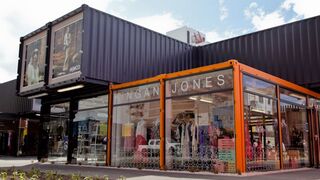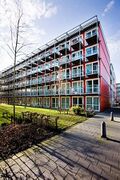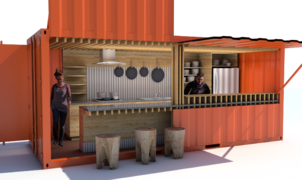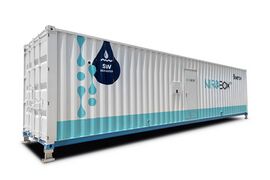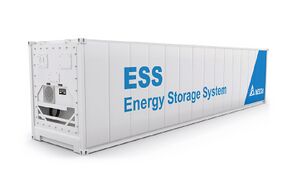Active Street: Difference between revisions
No edit summary |
No edit summary |
||
| (14 intermediate revisions by the same user not shown) | |||
| Line 9: | Line 9: | ||
|chapter=Active Transit | |chapter=Active Transit | ||
|summary=The vision to connect the end of the TriMet MAX line in Hillsboro to the Banks-Vernonia State Trail… has been a part of city and regional plans for many years. The section of this trail that runs along an old rail line between Hillsboro and Forrest grove offers some exciting opportunities for this Active Street™ concept. | |summary=The vision to connect the end of the TriMet MAX line in Hillsboro to the Banks-Vernonia State Trail… has been a part of city and regional plans for many years. The section of this trail that runs along an old rail line between Hillsboro and Forrest grove offers some exciting opportunities for this Active Street™ concept. | ||
}} | }}__NOTOC__ | ||
The Active Street™ concept combines active modes of transit such as walking and cycling with Low-speed electric vehicles (LSEVs). LSEV are a type of electric vehicle that operate at speeds below 35 miles per hour. These vehicles are typically smaller and more maneuverable than traditional vehicles, making them ideal for short trips within communities and urban areas. LSEVs are often used for personal transportation, delivery, and commercial purposes. They are known for being environmentally friendly, as they emit zero emissions and are powered by clean, renewable electricity. | The Active Street™ concept combines active modes of transit such as walking and cycling with Low-speed electric vehicles (LSEVs). LSEV are a type of electric vehicle that operate at speeds below 35 miles per hour. These vehicles are typically smaller and more maneuverable than traditional vehicles, making them ideal for short trips within communities and urban areas. LSEVs are often used for personal transportation, delivery, and commercial purposes. They are known for being environmentally friendly, as they emit zero emissions and are powered by clean, renewable electricity. | ||
<gallery mode="packed-hover"> | <gallery mode="packed-hover"> | ||
Image:P042914PS-0127 (14331409494).jpg|''[[commons:COMET electric vehicle|COMET electric vehicle]]'' (Pangia) | Image:P042914PS-0127 (14331409494).jpg|''[[commons:COMET electric vehicle|COMET electric vehicle]]'' (Pangia) | ||
Image:Xiaomi M365.jpg|''[[commons:Xiaomi M365|Xiaomi M365]]'' (Xiaomi) | Image:Xiaomi M365.jpg|''[[commons:Xiaomi M365|Xiaomi M365]]'' (Xiaomi) | ||
Image: | Image:Modern Cargo Trike In London.jpg|''[[commons:Cargo_bike|Cargo_bike]]'' (London Cargo Bike) | ||
Image: | Image:Elektro-Rollstuhl 15 kmh.JPG|''Elektro Rollstuhl'' | ||
Image:Zoox autonomous vehicle at CVPR 2022.jpg|''Zoox autonomous vehicle'' | |||
Image:Jump Electric Bicycle by Uber in Munich.jpg|''Jump Electric Bicycle'' (Uber) | |||
Image: | |||
Image: | |||
</gallery> | </gallery> | ||
LSEVs complement active transit, such as walking, cycling, and public transit, by providing an alternative mode of transportation for short trips and filling the gap between walking and cycling and public transit. They can also help to reduce traffic congestion and air pollution in urban areas, as they are more efficient and emit fewer pollutants than traditional gas-powered vehicles. | LSEVs complement active transit, such as walking, cycling, and public transit, by providing an alternative mode of transportation for short trips and filling the gap between walking and cycling and public transit. They can also help to reduce traffic congestion and air pollution in urban areas, as they are more efficient and emit fewer pollutants than traditional gas-powered vehicles. | ||
| Line 33: | Line 27: | ||
LSEVs can also help to support active transit by providing a convenient and accessible means of transportation to and from transit hubs, such as bus and train stations. They can also help to extend the reach of public transit, as they can travel to areas where larger vehicles cannot, providing more options for people to reach their destinations. In addition, LSEVs can also help to reduce the need for parking in densely populated areas, freeing up space for other uses. | LSEVs can also help to support active transit by providing a convenient and accessible means of transportation to and from transit hubs, such as bus and train stations. They can also help to extend the reach of public transit, as they can travel to areas where larger vehicles cannot, providing more options for people to reach their destinations. In addition, LSEVs can also help to reduce the need for parking in densely populated areas, freeing up space for other uses. | ||
==The Corridor== | |||
Converting the disused railway line between Hillsboro and Forest Grove, Oregon into an active transit corridor not only connects the communities of Forrest Grove and Cornelius to the TRIMET Light Rail station in Hillsboro but also has the potential to provide a number of opportunities for affordable housing and retail development along the route. This type of development can help to create vibrant and livable communities that are well-connected to the transit network and provide affordable housing options for people in the region. | |||
The 60' wide disused rail corridor has space to provide a catalyst for affordable housing and retail development, as it can attract new investment and development to the area. The conversion to an active transit corridor can provide the infrastructure and services needed to support new housing and retail development, such as improved access to water, sewer, and power services. In addition, the development of an active transit corridor can increase the visibility and accessibility of the area, making it an attractive location for investment and development. | |||
The development of affordable housing and retail along the route can help to create mixed-use, walkable communities that are well-connected to the transit network, reducing the need for single-occupancy vehicles and promoting physical activity creating new jobs, increasing tax revenue, and improving local businesses. | |||
[[File:CorridorHillsboro.jpg|Hillsboro, Cornelius, Forrest Grove Corridor|center]] | |||
==Modular Construction== | |||
The use of rapidly deployable modular buildings to provide affordable housing and retail along the along the corridor between Hillsboro and Forest Grove, Oregon provides a unique opportunity to address the need for affordable housing and retail development in the region. Modular buildings are prefabricated structures that can be constructed off-site and then transported to the desired location, where they can be rapidly deployed. This approach focuses on building walkable, well-connected, mixed-use communities first and replacing temporary structures with permanent structures only when the needs of the community are well established. | |||
<gallery mode="packed-hover"> | |||
Image:Retail.jpg|''Retail'' | |||
Image:Living.jpg|''Living'' | |||
Image:Farming.jpeg|''Farming'' | |||
Image:CoffeeShop.png|''Coffee Shop'' | |||
</gallery> | |||
==Revenue Opportunities== | |||
There are several opportunities to deliver containerized energy, water and waste facilities to support a regenerative community, including: | |||
*Off-grid solutions: Containerized solutions can be deployed in remote or off-grid communities where traditional infrastructure is not available, providing a reliable source of energy, water, and waste management. | |||
*Modularity and scalability: Containerized solutions offer a high degree of modularity and scalability, making it possible to easily expand or reduce the size of the system as needed to meet changing demands. | |||
*Cost-effectiveness: Containerized solutions can be more cost-effective than traditional infrastructure, especially in remote or off-grid locations, as they can be manufactured and transported to the site at a lower cost. | |||
*Sustainability: Containerized energy, water and waste facilities can be designed to use renewable energy sources, promote water conservation and recycling, and reduce waste. This makes them a sustainable option for communities looking to reduce their environmental impact. | |||
*Quick Deployment: Containerized solutions can be deployed quickly, reducing the time required to bring essential services to a community. | |||
*Flexibility: Containerized solutions can be relocated if needed, providing flexibility in case of changes in the community's needs or location. | |||
*Improved quality of life: By providing reliable access to energy, water, and waste management services, containerized solutions can improve the quality of life for residents in regenerative communities. | |||
<gallery mode="packed-hover"> | |||
Image:Water.jpg|''[[Smart Water|Smart Water]]'' | |||
Image:Waste.jpg|''[[Smart Waste|Smart Waste]]'' | |||
Image:Energy.jpeg|''[[Smart Grid|Energy]]'' | |||
</gallery> | |||
Latest revision as of 07:04, February 13, 2023
| Active Street | |
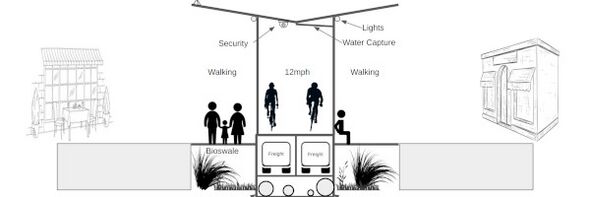 Active Street™ | |
| Team Organizations | Urban.Systems |
| Point of Contact | Wilfred Pinfold |
| Participating Municipalities | Cornelius OR |
| Sectors | Transportation |
| Initiative | |
| Status | Concept only Stage |
| Last Updated | December 15, 2025 |
Summary
The vision to connect the end of the TriMet MAX line in Hillsboro to the Banks-Vernonia State Trail… has been a part of city and regional plans for many years. The section of this trail that runs along an old rail line between Hillsboro and Forrest grove offers some exciting opportunities for this Active Street™ concept.
The Active Street™ concept combines active modes of transit such as walking and cycling with Low-speed electric vehicles (LSEVs). LSEV are a type of electric vehicle that operate at speeds below 35 miles per hour. These vehicles are typically smaller and more maneuverable than traditional vehicles, making them ideal for short trips within communities and urban areas. LSEVs are often used for personal transportation, delivery, and commercial purposes. They are known for being environmentally friendly, as they emit zero emissions and are powered by clean, renewable electricity.
-
COMET electric vehicle (Pangia)
-
Xiaomi M365 (Xiaomi)
-
Cargo_bike (London Cargo Bike)
-
Elektro Rollstuhl
-
Zoox autonomous vehicle
-
Jump Electric Bicycle (Uber)
LSEVs complement active transit, such as walking, cycling, and public transit, by providing an alternative mode of transportation for short trips and filling the gap between walking and cycling and public transit. They can also help to reduce traffic congestion and air pollution in urban areas, as they are more efficient and emit fewer pollutants than traditional gas-powered vehicles.
LSEVs can also help to support active transit by providing a convenient and accessible means of transportation to and from transit hubs, such as bus and train stations. They can also help to extend the reach of public transit, as they can travel to areas where larger vehicles cannot, providing more options for people to reach their destinations. In addition, LSEVs can also help to reduce the need for parking in densely populated areas, freeing up space for other uses.
The Corridor
Converting the disused railway line between Hillsboro and Forest Grove, Oregon into an active transit corridor not only connects the communities of Forrest Grove and Cornelius to the TRIMET Light Rail station in Hillsboro but also has the potential to provide a number of opportunities for affordable housing and retail development along the route. This type of development can help to create vibrant and livable communities that are well-connected to the transit network and provide affordable housing options for people in the region.
The 60' wide disused rail corridor has space to provide a catalyst for affordable housing and retail development, as it can attract new investment and development to the area. The conversion to an active transit corridor can provide the infrastructure and services needed to support new housing and retail development, such as improved access to water, sewer, and power services. In addition, the development of an active transit corridor can increase the visibility and accessibility of the area, making it an attractive location for investment and development.
The development of affordable housing and retail along the route can help to create mixed-use, walkable communities that are well-connected to the transit network, reducing the need for single-occupancy vehicles and promoting physical activity creating new jobs, increasing tax revenue, and improving local businesses.
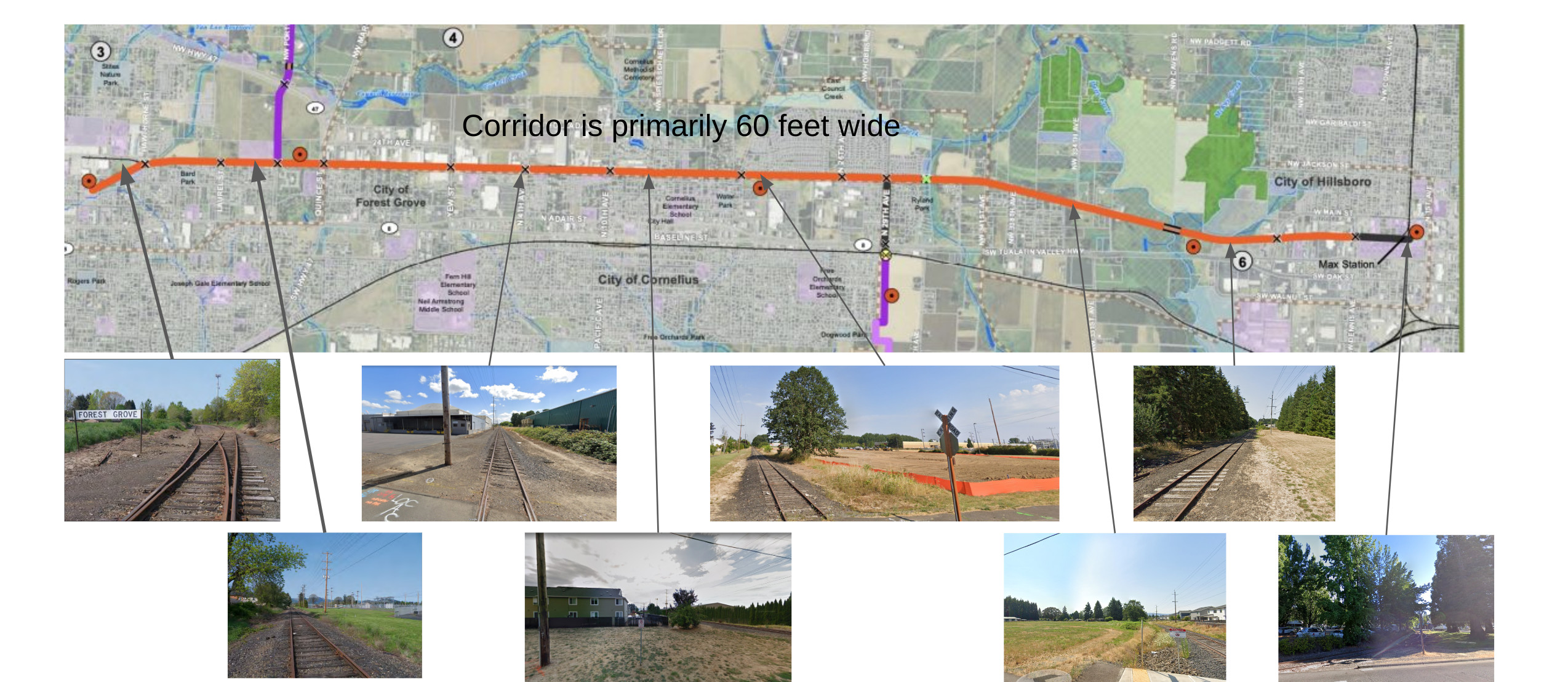
Modular Construction
The use of rapidly deployable modular buildings to provide affordable housing and retail along the along the corridor between Hillsboro and Forest Grove, Oregon provides a unique opportunity to address the need for affordable housing and retail development in the region. Modular buildings are prefabricated structures that can be constructed off-site and then transported to the desired location, where they can be rapidly deployed. This approach focuses on building walkable, well-connected, mixed-use communities first and replacing temporary structures with permanent structures only when the needs of the community are well established.
-
Retail
-
Living
-
Farming
-
Coffee Shop
Revenue Opportunities
There are several opportunities to deliver containerized energy, water and waste facilities to support a regenerative community, including:
- Off-grid solutions: Containerized solutions can be deployed in remote or off-grid communities where traditional infrastructure is not available, providing a reliable source of energy, water, and waste management.
- Modularity and scalability: Containerized solutions offer a high degree of modularity and scalability, making it possible to easily expand or reduce the size of the system as needed to meet changing demands.
- Cost-effectiveness: Containerized solutions can be more cost-effective than traditional infrastructure, especially in remote or off-grid locations, as they can be manufactured and transported to the site at a lower cost.
- Sustainability: Containerized energy, water and waste facilities can be designed to use renewable energy sources, promote water conservation and recycling, and reduce waste. This makes them a sustainable option for communities looking to reduce their environmental impact.
- Quick Deployment: Containerized solutions can be deployed quickly, reducing the time required to bring essential services to a community.
- Flexibility: Containerized solutions can be relocated if needed, providing flexibility in case of changes in the community's needs or location.
- Improved quality of life: By providing reliable access to energy, water, and waste management services, containerized solutions can improve the quality of life for residents in regenerative communities.






